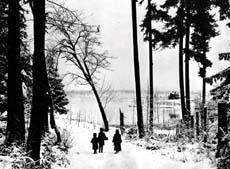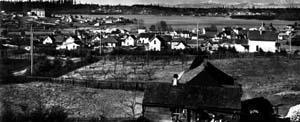By Sharon Boswell
and Lorraine McConaghy
Special to The Times

Children walk through the snowy lane on Green Lake's southern shore
at the turn of the century. The only building in sight is the McDonald homestead.
Photo credit: Seattle Times.
AS THE NEW CENTURY BEGAN, SEATTLE ENTERED A REMARKABLE PROSPERITY,
driven by the Klondike bonanza and the city's emerging position as marketplace,
factory town and regional port. Very rich, Seattle had also grown very big,
its population doubling during the 1890s, then almost tripling from 80,000 to
237,000 between 1900 and 1910.
The city's movers and shakers held an unquestioning faith in the benefits of "Progress." Seattle,
they were sure, would become more metropolitan, and boosters called for a concert hall,
a first-class hotel, a towering cityscape. But Seattle was about to grow out as well
as up, directing development along narrow corridors of suburban sprawl.
Population growth powered Seattle's early suburbanization, fueled by local prosperity,
people's wish for a place of their own, new technologies of public transit, and the ready availability of land.
In 1891, the city had annexed Magnolia Bluff and northern Queen Anne Hill,
as well as the broad strip of land that would one day become the Green Lake,
Fremont, Wallingford and University neighborhoods.
But in 1907 -- in one year -- Seattle doubled in area by annexing Ballard, West Seattle, South Park,
Columbia City, Rainier Beach and Ravenna; three years later, refined Laurelhurst and raffish
Georgetown joined the mix.
Seattle's street railways increased residential development
by linking these distant districts to city jobs, shopping and entertainment.
Seattle's first public horsecar began operating in 1884,
hauled at a stately pace on tracks laid in the mud of Second Avenue.
Six years later, city folk could ride cable cars along Yesler Way or
Madison Street out to the beaches of Lake Washington.
Beginning in the 1890s and continuing into the new century,
electric streetcar lines spread across the city and beyond,
tracing vital pathways to the University District, Rainier Valley
and out to West Seattle. Real-estate developers purchased strips of
land parallel to the tracks, buying up the old farms and logged-over acreage at the ends of the line.

Looking west across Green Lake and the streetway railway on its shore,
this 1903 photo shows the new family homes growing up along "the Loop."
Photo Credit: Asahel Curtis, Special Collections, UW Libraries.
SUDDENLY, THE NEWSPAPERS EXPLODED WITH DISPLAY ADS for "Just the Right Workingman's Cottages" and "The Ideal
Bowers to Shelter Your Family." Promoters lured homeseekers with free Saturday streetcar excursions
out to the "Grandest New Home City of All!," with ice cream and lemonade for the kids. "Be Wise!"
yelled the ads, "Use Your Rent Money to Buy a $50 Lakefront Lot on the 5-cent Car Line!"
The streetcar lines pulled neighborhood development in slender threads from the dense urban core,
creating suburbs in an intricate pattern of class, taste, occupation, race and ethnicity.
Once, only the wealthy could afford the time to travel by horsedrawn carriage
from their suburban retreats to their city businesses; in 1910, Seattle's morning
streetcars were packed with teachers, shipwrights and bookkeepers, middle-class wageworkers
commuting from their own neighborhoods to the city's office and industrial jobs.
Streetcar travel became part of Seattle's public culture and demanded a new etiquette.
The Times published guides to the niceties of greeting strangers, sharing a newspaper
or yielding one's seat to the elderly. High-school students were drilled
in streetcar-safety techniques, and young ladies worried about flashing
too much ankle as they hopped on and off the car. Seattle's daily papers
covered streetcar news, from pickpockets and late-night carousers to clumsy
derailments and spectacular crashes.
Photographs of Seattle's cityscape taken in the first decade of this century
feature views of crowds on downtown sidewalks, bustling into department stores and office buildings.
Meant to document Seattle's prosperity and urbanity, these images underscore
its successful imitation of established Eastern cities. But another
important part of Seattle's story between 1900 and 1910 was less metropolitan
and more suburban, a dynamic process of changing land use that created a city of homes in
far-flung neighborhoods of distinct character.
Historians Sharon Boswell and Lorraine McConaghy teach at local
universities and do research, writing and oral history. Original newspaper
graphics courtesy of the Seattle Public Library.